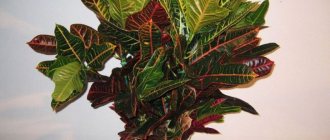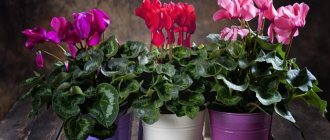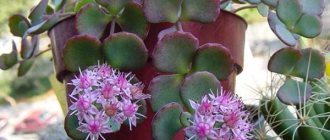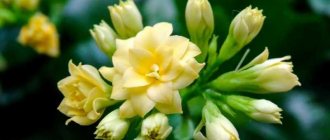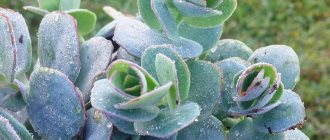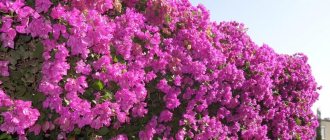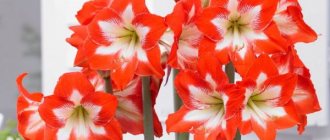Plants » Flowers
0
1329
Article rating
Kira Stoletova
The exotic flower Hoya belongs to the Lastovnevy family. It lives in the warm climate of Asia, Australia, America, India, and tropical islands. The plant was named after Thomas Hoy, an English gardener who was the first to study and grow different species in a greenhouse.
Hoya photo indoor photo
Description
The beautiful liana is a shrub with elastic and fleshy shoots that can grow up to 10 meters in length. At home, the length does not exceed 5 meters.
First of all, the smooth top with purple skin grows. Subsequently, it becomes green and leaves grow on it. At normal humidity, aerial roots form in the nodules. Over time, the stem hardens.
Leaves grow along the entire length of the shoots. Young leaves are soft and shiny. Later, the shine disappears, and the leaves become elastic and matte in structure. The leaf length varies from 5-8 cm, and the width - from 3-5 cm.
The plant is characterized by wave flowering. It begins in June and continues until autumn. Each whisk can last up to 21 days. Inflorescences appear on characteristic branches. Flowers are collected in oval umbrellas. The corolla includes a small crown framed by five petals.
Each bud resembles a white, pink or cream star. The crown is often very different in color saturation from the petals. In the presented photo of Hoya you can enjoy the beauty of the bush.
The pleasant and thick aroma of ivy flowers is designed to attract insects. Flowers produce large amounts of nectar. It is important to know that after flowering it is not advisable to remove the sprout, otherwise it will grow and produce new buds, according to the description of the flower.
How to take hoya cuttings to properly root the plant
In the question of how to properly cut hoya, special attention should be paid to pruning the cuttings. The best place for roots to appear is considered to be the area located under the node itself. Therefore, you need to leave a couple of centimeters of the stem under it, and cut off the rest. After a new shoot appears from the axil of the first node, you can cut off the second node and also root it.
Rooting is possible in one of two ways:
- Immediately in the substrate (at soil temperature +20...+25 °C).
- In water (at a temperature of + 22 ° C).
The first option is considered to be more reliable. Before rooting hoya cuttings, you need to prepare the soil according to one of the “recipes”:
- Mix equal parts of sphagnum moss (or peat), vermiculite (or perlite), fine expanded clay (or polystyrene foam).
- Combine fine expanded clay (1/5 part), perlite or vermiculite (1/5 part), planting soil (3/5 part).
The prepared substrate must be breathable so that the cuttings do not rot. Perlite or vermiculite will help ensure this soil property. You should also take care of the proper soil moisture, but the higher the level of its breathability, the faster the water evaporates from it. This problem can be solved using a plastic bag (how exactly will be discussed later).
Before rooting, for 100% results, you can treat the cuttings with Kornevin, but this is not necessary.
Landing
To plant the plant, you need to purchase a suitable pot. The crown of the shrub is prone to rapid growth, so it is important to take care of reliable support. The soil can be bought in ready-made briquettes, or you can make your own mixture from:
- Sphagnum moss;
- peat;
- perlite.
Important: in order to enjoy abundant flowering more often, select a tight container.
Purchase and adaptation
Adult hoya can be bought in special stores, but not every variety is easy to find. Many collectors or hobbyists sell cuttings for rooting via the Internet (gardening communities, forums, VK, ad sites, etc.). They offer not only popular, but also rare species (the price for cuttings is much lower than for rooted hoyka).
After purchasing, the vine (or cuttings) should be placed for two to three weeks separately from other plants. She is regularly examined for signs of illness. At this time, hoya cannot be trimmed, replanted, or fed.
Care
There are more than 50 subspecies of the plant. But only part of the genus has been cultivated. The most popular varieties among plant growers for home care are the Fleshy and Beautiful Hoya varieties. With effort and love, indoor Hoya flowers will be similar to those that grow in the tropics.
Hoya propagation
Growing from seeds
How to propagate hoya if you happen to be the owner of a rare treasure - hoya seeds? Ripe and well-dried hoya seeds in the year of their collection are sown in a loose substrate consisting of an earthen mixture and chopped sphagnum moss. The seeds germinate within a week, and as soon as the shoots appear, you must ensure that the soil in the crops never dries out and at the same time is not wet. Keep the bowl with seedlings in a warm, bright place.
- Yucca
To prevent fungal diseases, spray the seedlings with Bordeaux mixture or any other copper-containing preparation in strict accordance with the instructions. After 90 days, when the seedlings produce several pairs of leaves, they are planted in personal pots. However, growing hoya from seeds is made difficult by the fact that seed material cannot be found on sale, and it is almost impossible to obtain seeds from hoya growing at home.
Propagation by cuttings
This is the easiest and most reliable way to get a new plant, since Hoya cuttings take root easily. The stalk should be short, but have at least two nodes and one or two pairs of leaves. You can root cuttings in water or in a substrate. To root in water, wrap the container with foil on all sides, making holes for the cuttings. Leave only the top pair of leaves on the cuttings, treat the lower sections with rooting hormone and push the cuttings through the holes in the foil to such a depth that the lower node is in the water.
The temperature for rooting should not be higher than 22 ºC, but high air humidity is also important for this process, otherwise the cuttings will simply wither. To increase air humidity, place a transparent plastic bag over the container with cuttings, but do not block the air access underneath it. Hoya rooting occurs after two weeks, and it is important to transplant the cuttings to a permanent place at an early stage of root formation, otherwise the cuttings become fragile and break.
How can you root Hoya directly in the substrate? The soil for rooting must have such permeability that excess water can easily flow through it. Before planting, treat the lower cut of the cuttings with root. Sterilize the substrate and pot, place the cutting in the soil to such a depth that the bottom node is in the soil. If the air humidity in the room is low, place a transparent bag loosely over the pot with cuttings. After 2-3 weeks, signs of new growth should appear. If you received cuttings for rooting in the mail and it seems to you that they are too dry, soak them for several hours in slightly sweet water and they will restore their moisture.
Temperature
In the room where the flower grows, the air temperature should be between 20 - 30 degrees. Periodically, the leaves of the evergreen vine plant need to be sprayed with water. The room should be ventilated. In the summer, you can take the flower out into the fresh air - a balcony or terrace.
In the cold season, a flower can be resistant to a temperature drop of 15 degrees, but no more. The optimal indoor temperature in winter is 16-18 degrees. If the bush has been exposed to hypothermia, it will most likely begin to dry out and may soon die.
Types and varieties
Not so long ago, only Hoya carnosa, or Hoya fleshy, and Hoya bella, also known as Hoya beautiful, represented the indoor plant Hoya in cultivation.
Fleshy Hoya (Hoya carnosa), or waxy Hoya
An evergreen climbing plant, reaching a length of 6 meters and requiring support. Fragrant flowers, white with a pink crown in the center, are collected in a rosette. It has small oval leaves, thick and tough, covered with a waxy coating and silvery markings on a dark green background.
Although there are varieties of this species:
- Hoya variegated (for example, the Crimson Queen variety with a cream border along the edge of the green leaf);
- Hoya tricolor - the “Exotic” variety with scarlet flowers, and the leaves, in addition to green, are colored in cream and pink shades;
- Hoya compacta is a variety with small leaves and barely noticeable patterns on them.
Hoya bella
A branching shrub with small, ovate-lanceolate, densely growing leaves on hanging shoots. The flowers of this species are so perfect that they seem like jewelry - small white stars with a purple crown, collected in umbrellas of 7-9 pieces. The leaves, depending on the variety, can be solid green or variegated. Hoya beautiful is often grown as an hanging plant.
In addition to these two well-established species in culture, today they are becoming increasingly widespread:
Hoya multiflora, or multi-flowered
A climbing plant with oblong-linear leaves and numerous yellow flowers with narrow petals and a crown with arched spurs;
Hoya majestic (Hoya imperialis)
In nature, it is a shrub with oval-oblong leathery leaves 15-20 cm long on pubescent cuttings 5-7 cm long. The shoots are also pubescent. Fragrant flowers, collected in umbels of 6-10 pieces, with a short pubescent crown, dark red on the inside and yellow-green on the outside;
Hoya lacunosa, or concave (Hoya lacunosa)
In nature, it is an epiphyte; in culture, the shoots look like densely growing cascades of lashes, covered with dark green diamond-shaped leaves up to 6 cm long with curled edges, which is why the leaf plate appears concave. Young shoots have a red-brown tint. The flowers collected in umbels have a white fleecy corolla with a yellow center;
Hoya Kerry (Hoya kerrii)
It has leaves shaped like a heart, which is why it is called “Valentine” or “hoya in love.” The stems have to be tied up to prevent them from falling. The leaves are succulent, length and width from 5 to 15 cm. The pubescent flowers are collected in 15-25 pieces in spherical umbrellas, their color depends on the amount of light in the room where the hoya grows: white with a barely noticeable lemon tint, yellowish, yellow-lemon or soft pink. Move the flower further away from the window or, conversely, closer to it, and the shade of the flowers will change. Moreover, as it ages, due to the dark-colored nectar, the flower’s petals become pink, then dark pink, then red-brown.
Hoya serpentine (Hoya serpens), fragrant hoya (Hoya odorata), cupped hoya (Hoya calycina), Hoya mindorensis (Hoya mindorensis), southern hoya (Hoya australis) and others are also known in culture.
Lighting
In order for the bush to delight with lush flowering and grow well, you need to choose the ideal place. It should be slightly shaded, it is important to avoid direct sunlight.
Ivy is a hanging plant. Because of this, it can entwine the entire room, becoming a beautiful decoration in the house. Flower growers should avoid keeping shrubs near heating devices during the cold period, as this may cause the plant to dry out.
Evergreen liana needs long-term lighting. Breeders recommend additional lighting of the plant during the flowering period. The total daylight hours should be 14 hours. In winter, wax ivy also needs additional lighting, with the difference that the daylight hours are 10 hours.
A distinctive feature of the vine is its pungent odor. Therefore, you should not hang it in the bedroom. To avoid unnecessary problems when growing lianas, it is recommended to purchase wooden or metal supports and tie the liana stems to them.
You can allow long strands to simply fall out of the flower pots. According to the rules for growing at home, to avoid unwanted branching, the tips of the stems are pinched.
Necessary growing conditions
How to root hoya from cuttings
- Hoya prefers bright, but diffused sunlight - the flowering process directly depends on this: if there is insufficient lighting, the vine will not bloom. It should be placed closer to the window, and in winter it should be artificially illuminated.
- The optimal temperature is 20-22°C. It should not fall below 15 °C (for some species - up to 10 °C).
- Humidity is moderate. In dry times, spraying is useful. A warm bath is sometimes used to make the hoyka bloom.
Proper watering
From spring to late autumn, the flower needs moderate watering. You must adhere to certain rules on how to water a flower. The procedure is carried out once a week. The water must be soft. When using tap water, it should be left to sit for 24 hours so that harmful chlorine can evaporate.
From November, the watering interval can be reduced to once every two weeks. The plant needs to be bathed twice a year. As a rule, this is done with the onset of spring before flowering and in late autumn, when the flowers have faded. For bathing, use a basin of water into which a pot with a plant is immersed.
The water temperature for swimming is 40 degrees. This is a very useful procedure for the flower, stem and root system of the plant. After this, it begins to grow well in the spring, and bathing in the autumn hardens the plant and helps it endure the cold period.
Choosing a pot and soil
A small pot is enough for this plant to thrive. Its usual environment is large trees and rocks. Therefore, when planting this flower at home, you need to plant it in small containers where air can flow well. In the photo you can see how hoya looks great in a small pot.
It doesn’t matter what the container is made of, any material will do. The soil where the plant will move should preferably be loose, with the addition of humus from the leaves. As a rule, many types of hoya grow quietly in any soil. But some varieties require limestone in the substrate.
Air humidity
At normal air humidity in the room, the vine grows well. If the humidity is low, you need to install a tray on which to place the container with the plant, and pour wet expanded clay into it. It’s a good idea to spray the air near the plant from time to time.
Is it possible to keep Hoya at home?
Most often, Hoya is grown not in apartments, but in offices and studies, and the reason for this is superstition. For a long time, people believed that wax ivy survives the husband’s family and drives adult sons out of the house. Other, no less convincing sources claim that hoya relieves feelings of resentment and pacifies envy. There are publications that say that hoya is “a plant of family happiness, it is advisable to place it in the bedroom.” What to believe? Maybe it’s worth trying to grow hoya at home and clarify the degree of its influence on a person’s destiny? You decide. I see in hoya only a cozy plant with beautiful flowers, caring for which is a pleasure.
Fertilizer
Twice a month, ivy needs to be nourished with a special mineral complex. The prepared solution is slowly poured into the soil at a short distance from the roots.
Transfer
Young Hoya specimens require replanting every spring. Adult plants are moved to a new pot no more often than once every 3 years. Signs that wax ivy needs a larger container:
- roots peeking out of drainage holes;
- growth slows down;
- the leaves droop.
Before replanting a newly purchased plant, wait until the end of flowering or spring. At this time, it is not recommended to place the pot near other flowers.
Soil selection
For wax ivy, neutral soil is used. The maximum permissible pH is 6.5.
For planting hoya, store-bought mixtures intended for orchids are recommended.
To make your own soil suitable for wax ivy, mix:
- leaf and turf soil;
- sand;
- moss;
- peat;
- charcoal.
Some gardeners plant hoya in loam enriched with humus and mixed with universal soil in a 2:1:1 ratio.
The main requirement is that the soil must be loose and allow air to pass through well.
Possible difficulties
The shrub has strong immunity and resistance to various diseases. Only with inappropriate care can a plant be attacked by a fungus.
In hot weather, the plant may be attacked by aphids, mealyworms and other pests. In this case, flower growers treat the stems and soil with an insecticide. It is very difficult to get rid of nematodes.
If a plant is infected by this pest, you should resort to drastic methods - cut out healthy cuttings and destroy the diseased shoots. Before planting, the soil and container are sterilized.
Spots on leaves can appear both with a lack of light and with an excess of light. Weak stems and pale leaf color are signs of a lack of fertilizer.
Additional questions for flower growers
If you also have questions about caring for your hoya, ask them in the comments.
How to make it bloom
If the hoya does not produce buds, it needs to be prepared for next year:
- in autumn, bathe in warm water;
- arrange wintering in a cool place, without fertilizers and with a minimum of watering;
- in the spring, transplant into a new nutrient substrate;
- bathe again in warm water.
Is it possible to leave a flower without care?
The plant is capable of storing water in its fleshy leaves. Like any succulent, it can be watered abundantly, mulched with moss, and placed on damp expanded clay.
In such conditions, a flower can spend 2-3 weeks without watering, even in summer, and not die.
Is it possible to keep wax ivy at home?
Because of the name wax ivy, many gardeners are suspicious of hoya. But this plant is not poisonous.
Allergies can only be caused by pollen upon direct contact with it.
Some esotericists consider hoya to be a plant that threatens the owner with poverty and loneliness. But according to Feng Shui, it, on the contrary, helps strengthen marriage.
Wax ivy is also credited with the ability to reduce aggression and competition.
Does the plant have any beneficial properties?
Traditional medicine practitioners use hoya leaves to treat acne and migraines. The aroma of wax ivy flowers is considered an aphrodisiac.
Signs and superstitions
There are so many different legends around the flower that some people are afraid to have one. Women refer to it as a plant that keeps men out of the house. Another category believes in the opposite belief, which is based on the theory that the flower, on the contrary, promotes the affection of people.
No matter what anyone says, the tropical hoya plant with its rich greenery and specific fragrant buds deserves attention. Wax ivy deserves to be nurtured with love. And you shouldn’t pay attention to prejudices.
Diseases and pests
| Problem | Symptoms | Prevention | Control measures |
| Shchitovka | Pest insects look like dark brown bumps. | Proper care and maintenance conditions: watering, fertilizing, pruning. Frequent spraying of hoya and shower procedures, regular airing of the room, quarantine for new plants. | Wash the hoyka with tar soap. Remove plaques with a delicate brush. If pests are not removed, treat with Fitoverm. |
| Aphid | Small light green bugs. The leaves turn yellow, dry, and curl. | Cut off affected leaves and wash with soapy water. In case of severe pest infestation, use insecticides (Intavir, Fas, Karate). | |
| Whitefly | The appearance of larvae and white insects with wings (they multiply quickly). Shiny coating on leaves and sooty fungus. | Wash the Hoya with soap, water and alcohol. Hang sticky traps and collect caterpillars by hand. Change the top layer of soil in the pot. In serious cases, use Actellik or Confidor. | |
| Root and stem rot | Wax ivy does not grow. Dark softened areas appear on the stems. The leaves wither and fall off. | Avoid overwatering. Disinfect the flowerpot, drainage materials, and tools when replanting. Disinfect sections and |
Photo of Hoya plant
How to transplant a Hoya into a new pot
The “plus” of growing the crop is that it does not require frequent replanting. It is carried out, if necessary, once every 1-3 years in the spring. Recommended substrate: flower soil mixture “For flowering succulents” or prepared independently according to one of the “recipes” discussed above.
Usually, the plant itself signals that replanting is necessary: the root system protrudes from the drainage into the holes at the bottom of the flowerpot, the bush or vine does not grow, and the leaves become drooping.
Before replanting your home hoya, you need to choose the right new pot. If the goal is to get abundant flowering, then the container should not be much larger than the one in which the crop grew before. If it is necessary to stimulate the growth of a bush or vine, then the pot should be much more spacious than the previous one. You must not forget to place drainage at the bottom (pebbles, broken shards, stones measuring from 1 to 1.5 cm, foam chips).
Transplanting a healthy crop into a new container and fresh substrate is carried out using the transfer method - that is, an earthen ball entwined with roots is not destroyed, but is transferred to another container and supplemented with the required amount of soil. When planting, the hoya is not deeply buried; the transplanted plant requires standard care - as described above.
Pruning and shaping hoya
An important aspect of caring for hoya when growing it at home is pruning. The procedure is carried out during transplantation. It is necessary to remove those shoots that are excessively long - this will promote abundant flowering of the plant. To make the stems branch, use the method of pinching the tips after the fourth leaf is formed.
To form the crown of vines, supports are used. If the shoots are flexible, then rings, hearts, arches, spirals, etc. are suitable. Branches are secured to windows or walls with threads. Hanging plants can be left hanging from the pots. The main thing is to make sure that the flowerpot is light, otherwise the risk of it tipping over will increase.



